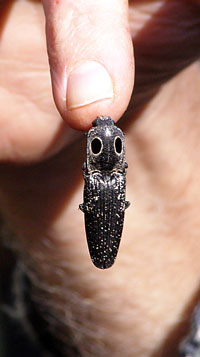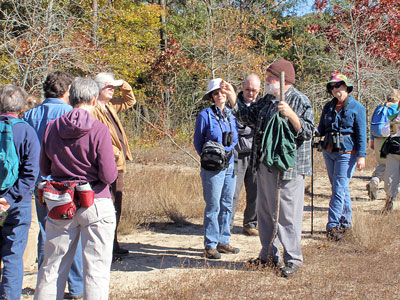Exploring with like-minded folk
By Ken Moore
Flora Columnist
Thanksgiving Day included a walk in the woods. Lingering fall color and the beautiful beginnings of the winter forest landscape were worthy of giving thanks.
We left the neighborhood behind at the end of the street as we entered Carolina North woods to walk the Nature Observation Trail, a trail for walkers only, where we like-minded folk enjoyed the nature of the place without interruption from dogs, bikes and joggers. We were alone on that deer path-like trail beneath giant trees beginning to show off winter forms and textures. Along the way, we became absorbed in the diversity of fallen leaves on the forest floor and the complexity of hidden activity beneath.
Our emergence back onto the street was a bit unsettling after the journey over the leafy forest carpet.
Curbs were piled with leaves removed from manicured landscapes upon which they had fallen. We surveyed that scene and reflected on how far we humans have diverged from living in harmony with nature. We wondered how town resources could be redirected if all those leaves were allowed to remain, to be recycled as nature intended, on the ground where they fall.
We further reflected on how thankful we are to have numerous public trails nearby to offer solace from the trappings of manicured neighborhoods.
However, sometimes it’s exhilarating to go farther afield to explore new places.
One such place I’ve wanted to explore is Howell Woods in nearby Johnston County. Several weeks ago, I joined like-minded folk in the able hands of N.C. Museum of Natural Sciences naturalists Jerry Reynolds and Jesse Perry on a day-long exploration of the 2,800-acre “outdoor classroom†associated with Johnston Community College’s Rudolph Howell and Son Environmental Learning Center.
You are welcome to visit Howell Woods (howellwoods.org) on your own. There are attractions to engage the entire family. Twenty-five miles of trails, 24 separate loop trails, introduce you to a diversity of habitats including bottomland hardwood forests, seasonal wetlands with boardwalks, sandhill pine and scrub oak and longleaf pine forest restorations.
If you visit on a weekend, look for Stephen Ashby, a staff member who cares for the wildflower and other gardens next to the learning center. He’s full of helpful information about the history and nature of the place.
Jerry and Jesse quickly identified discoveries made by the members of our group, who were scrambling in all directions like preschoolers. Highlights spotted were marble salamanders, late-fall grasses and wildflowers and the brilliant color of turkey oaks, which hold their leaves perpendicular to the ground to conserve moisture. I was most excited to see the eyed elater click beetle found beneath fallen leaves inside a rotting log. When asked, “Does it bite?†Jesse obliged in demonstrating that it does, and it tagged along on Jesse’s finger for quite a ways. (Jesse was good-natured about it!)
Jerry Reynolds schedules monthly Museum day trips (naturalsciences.org) to natural areas not far from Raleigh. The next one is Dec. 8 to Raven Rock State Park below Sanford. There may still be spaces left.
Whatever you do, get out into nature, leave your worries behind and let those leaves remain beneath the trees where they fall.
Email Ken Moore at flora@carrborocitizen.com.




Comments are closed.